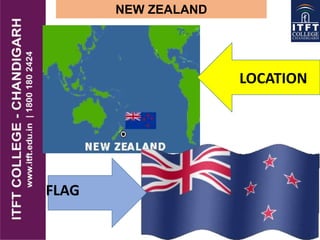Itft new zealand physical features
•Download as PPTX, PDF•
1 like•1,921 views
New zealand introduction, new zealand general geography,.... New zealand main Islands..north islands south islands main geographic divisions of New zealand... Natural vegetation and Animal life of newzealnd...economy of new zealand
Report
Share
Report
Share

Recommended
Recommended
More Related Content
What's hot
What's hot (20)
Viewers also liked
Viewers also liked (7)
Similar to Itft new zealand physical features
Similar to Itft new zealand physical features (20)
Immigrate to Australia or Study in Australia - Here the Guide For You

Immigrate to Australia or Study in Australia - Here the Guide For You
The Culture, Etiquette and Customs of Australia and New Zealand

The Culture, Etiquette and Customs of Australia and New Zealand
More from Aruna Poddar
More from Aruna Poddar (10)
Recently uploaded
Mehran University Newsletter is a Quarterly Publication from Public Relations OfficeMehran University Newsletter Vol-X, Issue-I, 2024

Mehran University Newsletter Vol-X, Issue-I, 2024Mehran University of Engineering & Technology, Jamshoro
Recently uploaded (20)
This PowerPoint helps students to consider the concept of infinity.

This PowerPoint helps students to consider the concept of infinity.
ICT role in 21st century education and it's challenges.

ICT role in 21st century education and it's challenges.
Sensory_Experience_and_Emotional_Resonance_in_Gabriel_Okaras_The_Piano_and_Th...

Sensory_Experience_and_Emotional_Resonance_in_Gabriel_Okaras_The_Piano_and_Th...
Python Notes for mca i year students osmania university.docx

Python Notes for mca i year students osmania university.docx
Kodo Millet PPT made by Ghanshyam bairwa college of Agriculture kumher bhara...

Kodo Millet PPT made by Ghanshyam bairwa college of Agriculture kumher bhara...
Basic Civil Engineering first year Notes- Chapter 4 Building.pptx

Basic Civil Engineering first year Notes- Chapter 4 Building.pptx
Micro-Scholarship, What it is, How can it help me.pdf

Micro-Scholarship, What it is, How can it help me.pdf
Unit 3 Emotional Intelligence and Spiritual Intelligence.pdf

Unit 3 Emotional Intelligence and Spiritual Intelligence.pdf
Itft new zealand physical features
- 2. LOCATION New Zealand is an island country in the southwestern Pacific Ocean. New Zealand is situated some 1,500 kilometers east of Australia across the Tasman Sea. Because of its remoteness, it was one of the last lands to be settled by humans. The country geographically comprises two main landmasses ‒ that of the North and South Islands ‒ and numerous smaller islands.
- 3. CAPITAL OF NEWZEALAND Wellington is the capital city and second most populous urban area of New Zealand. It is at the southwestern tip of the North Island, It is home to 395,600 residents. Population: 4,107,000 Capital: Wellington Area:2,70,534 square kms Language: English, Maori Religion: Protestant, Roman Catholic Currency: New Zealand dollar
- 4. New Zealand is made up of two main islands and a number of smaller islands, located near the centre of the water. The main North and South Islands are separated by the Cook Strait 22 kilometers wide at its narrowest point. New Zealand have approximately 15,134 km of coastline and a total land area of 268,021 square kilometers. Because of its far-flung outlying islands and long coastline, the country has extensive marine resources. GEOGRAPHY
- 6. The South Island is the largest land mass of New Zealand, and is divided along its length by the Southern Alps. There are 18 peaks over 3,000 meters (9,800 ft), the highest of which is Mount Cook at 3,754 meters. The North Island is less mountainous but is marked by volcanism.
- 7. CLIMATE New Zealand has a mild climate with mean annual temperatures ranging from 10 °C in the south to16 °C in the north. Of the seven largest cities, Christchurch is the driest, receiving on average only 640 millimeters (25 in) of rain per year and Auckland the wettest, receiving almost twice that amount. The southern and south- western parts of the South Island have a cooler and cloudier climate.
- 8. The general snow season is about early June until early October in the South Island. It is less common on the North Island, although it does occur. Auckland, Wellington and Christchurch all receive a yearly average in excess of 2,000 hours of sunshine New Zealand is hit by a tropical cyclone once every eight to nine years. Cyclone Bola was one of the costliest cyclones in the history of New Zealand, causing severe damage as an extra tropical cyclone when it passed near the country in March 1988.
- 9. DEMOGRAPHY The population of New Zealand is approximately 4.4 million. New Zealand cities generally rank highly on international livability measures. For instance, in 2010 Auckland was ranked the world's 4th most livable city and Wellington the 12th by the Mercer Quality of Life Survey. Life expectancy at birth is forecast to increase from 80 years to 85 years in 2050 and infant mortality is expected to decline. The country has a young population compared to most industrialized nations, with 20 percent of New Zealanders being 14 years-old or younger. By 2050 the population is forecast to reach 5.3 million.
- 10. ECONOMY In Northland, the major form of pastoral farming is beef cattle. New Zealand is the world's eighth largest milk producer, with about 2.2% of world production. Throughout the 20th century agricultural imports have remained important to the New Zealand economy, contributing 50 percent of all export income. New Zealand is unique amongst developed countries in that almost half of our greenhouse gas emissions come from the agriculture sector.
